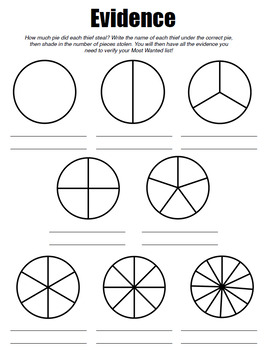Fraction Fugitives: Compare and Order Fractions to Catch Pie Thieves!
19,535 Downloads
Glee Sun Productions
74 Followers
Grade Levels
3rd - 6th
Subjects
Resource Type
Standards
CCSS3.NF.A.1
CCSS3.NF.A.3
CCSS4.NF.A.2
Formats Included
- PDF
Pages
7 pages
Glee Sun Productions
74 Followers
Description
Eight pie thieves are on the run after stealing different amounts of pie from a bakery! Kids help the police by creating a "Most Wanted" list which orders the thieves according to the amount of pie each thief stole. Kids must compare and order 8 different fractions to create their Most Wanted lists.
Should the police pursue Candyman Carl, the notorious pie thief who who stole 2/5 of a pie before they chase down Strawberry Sam for stealing 1/3 of a pie? Who stole more pie? Kids will use the included "Evidence" page to help answer these types of important questions! The Evidence page allows kids to shade in the different fractions so they can visually compare them.
This download includes:
*Fraction Fugitives activity
*Evidence page
*Teacher keys
*Wanted Poster activity for early finishers (requires no preparation...just print it!)
*Suggestions and tips for teachers
Should the police pursue Candyman Carl, the notorious pie thief who who stole 2/5 of a pie before they chase down Strawberry Sam for stealing 1/3 of a pie? Who stole more pie? Kids will use the included "Evidence" page to help answer these types of important questions! The Evidence page allows kids to shade in the different fractions so they can visually compare them.
This download includes:
*Fraction Fugitives activity
*Evidence page
*Teacher keys
*Wanted Poster activity for early finishers (requires no preparation...just print it!)
*Suggestions and tips for teachers
Total Pages
7 pages
Answer Key
Included
Teaching Duration
N/A
Report this resource to TPT
Reported resources will be reviewed by our team. Report this resource to let us know if this resource violates TPT’s content guidelines.
Standards
to see state-specific standards (only available in the US).
CCSS3.NF.A.1
Understand a fraction 1/𝘣 as the quantity formed by 1 part when a whole is partitioned into 𝘣 equal parts; understand a fraction 𝘢/𝑏 as the quantity formed by 𝘢 parts of size 1/𝘣.
CCSS3.NF.A.3
Explain equivalence of fractions in special cases, and compare fractions by reasoning about their size.
CCSS4.NF.A.2
Compare two fractions with different numerators and different denominators, e.g., by creating common denominators or numerators, or by comparing to a benchmark fraction such as 1/2. Recognize that comparisons are valid only when the two fractions refer to the same whole. Record the results of comparisons with symbols >, =, or <, and justify the conclusions, e.g., by using a visual fraction model.





